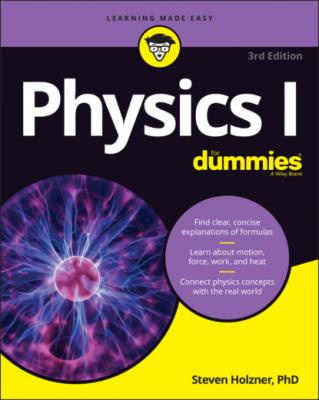Physics I For Dummies. Steven Holzner
Читать онлайн.| Название | Physics I For Dummies |
|---|---|
| Автор произведения | Steven Holzner |
| Жанр | Физика |
| Серия | |
| Издательство | Физика |
| Год выпуска | 0 |
| isbn | 9781119872245 |
Busting out the stopwatch: Average speed
Say, for example, that you want to drive from New York City to Los Angeles to visit your uncle’s family, a distance of about 2,781 miles. If the trip takes you 4.000 days, what was your average speed? You divide the total distance by the change in time, so your average speed for the trip would be
This solution divides miles by days, so you come up with 695.3 miles per day. Not exactly a standard unit of measurement — what’s that in miles per hour? To find it, you want to cancel days out of the equation and put in hours (see Chapter 2). Because a day is 24 hours, you can multiply this way (note that days cancels out, leaving miles over hours, or miles per hour):
That’s a better answer.
Contrasting average and instantaneous speed
If you travel 2,781 miles in 4.000 days (a total of 96 hours), you go at an average speed of 28.97 miles per hour. That answer seems pretty slow, because when you’re driving, you’re used to going 65 miles per hour. You’ve calculated an average speed over the whole trip, obtained by dividing the total distance by the total trip time, which includes non-driving time. You may have stopped at a hotel several nights, and while you slept, your instantaneous speed was 0 miles per hour; yet even at that moment, your overall average speed was still 28.97 miles per hour!
Distinguishing average speed and average velocity
There is a difference between average speed and average velocity. Say, for example, that while you were driving in Ohio on your cross-country trip, you wanted to make a detour to visit your sister in Michigan after you stopped by a friend’s house in Indiana. Your travel path may have looked like the straight lines in Figure 3-3 — first 80 miles to Indiana and then 30 miles to Michigan.
FIGURE 3-3: A trip from Ohio to Michigan.
If you drove at an average speed or a uniform speed of 55 miles per hour and you had to cover
The direction of the average velocity is just the direction between the start and end points. But if you’re interested in your average speed along either of the two legs of the trip, you have to measure the time it takes for a leg and divide the length of that leg by that time to get the average speed.
To calculate the average speed over the whole trip, you look at the whole distance traveled, which is
As another illustration of the difference between average speed and average velocity, consider the motion of the Earth around the sun. The Earth travels in its nearly circular orbit around the sun at an enormous average speed of something like 18 miles per second! However, if you consider one full revolution of the Earth, the Earth returns to its original position, relative to the sun, after one year. After one year, there’s no displacement relative to the sun, so the Earth’s average velocity over a year is zero, even though its average speed is enormous!
Speeding Up (Or Down): Acceleration
Acceleration is a measure of how quickly your velocity changes. When you pass a parking lot’s exit and hear squealing tires, you know what’s coming next — someone is accelerating to cut you off. After he passes, he slows down right in front of you, forcing you to hit your brakes to slow down yourself. Good thing you know all about physics.
Like speed, acceleration takes many forms that affect your calculations in various physics situations. In different physics problems, you have to take into account the direction of the acceleration (whether the acceleration is positive or negative in a particular direction), whether it’s average or instantaneous, and whether it’s uniform or nonuniform. This section tells you more about acceleration and explores its various forms.
Defining acceleration
Given the initial and final velocities, vi and vf, and the initial and final times over which your speed changes, ti and tf, you can also write the equation like this:
Acceleration, like velocity, is actually a vector and is often written as a, in vector style (see Chapter 4). In other words, acceleration, like velocity but unlike speed, has a direction associated with it.
Determining the units of acceleration
You
